10 Best Spotting Scopes for Target Shooting in 2025 – Reviews & Guide
Last Updated on
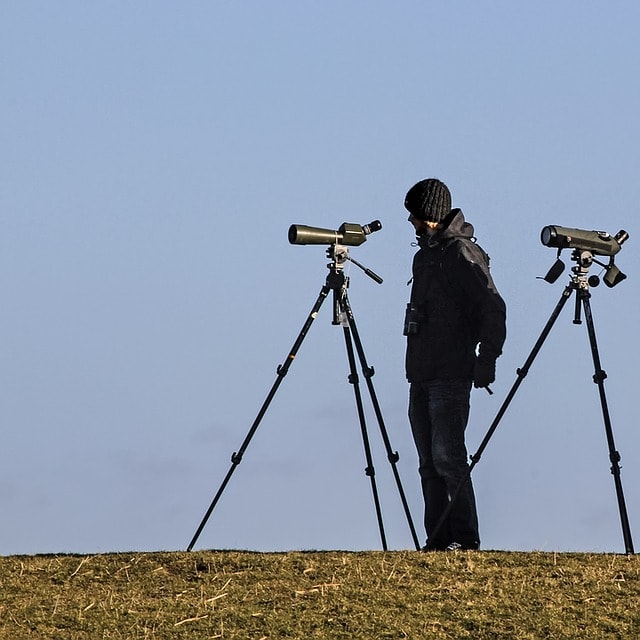
Choosing a spotting scope may seem like an easy task, but there is quite a large selection of models and features. Choosing the one that is perfect for you can prove to be a challenge. If you’re looking to avoid reading through hundreds of reviews, you have come to the right place.
We have already reviewed dozens of scopes designed for all types of uses, and we have chosen ten spotting scopes that we feel are worth yriour time (and money). Each one is perfect for target shooting, and we’ll break down exactly what we liked and didn’t like about each one. We’ve also included a buyer’s guide where we break down what’s important to look for when choosing your spotting scope so you can feel confident when purchasing on your own.
Keep reading for our detailed reviews of each scope, where we compare objective lenses, magnification, cell phone capabilities, and durability to help you make an educated purchase.
Let’s look at the spotting scopes we’ve chosen to review:

Our Favorites Choices of 2025 Compared
| Image | Product | Details | ||
|---|---|---|---|---|
| Best Overall |
 |
Celestron Ultima |
|
CHECK PRICE |
| Best Value |
 |
Huicocy 20-20x60 |
|
CHECK PRICE |
| Premium Choice |
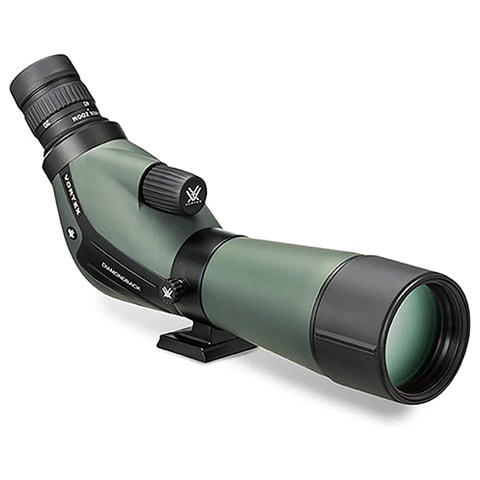 |
Vortex Optics Diamondback |
|
CHECK PRICE |
 |
Roxant Blackbird |
|
CHECK PRICE | |
 |
Gosky Target Shooting |
|
CHECK PRICE |
The 10 Best Spotting Scopes for Target Shooting
1. Celestron Ultima Spotting Scope – Best Overall
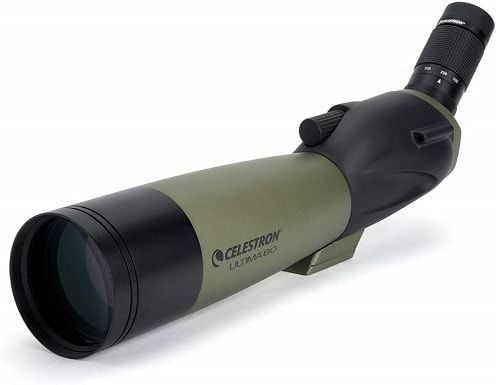
The Celestron 52250 Spotting Scope is our choice for best overall. It has some great features and isn’t too expensive. It features a large 80-mm objective lens for maximum light input. The lens coating prevents glare and flare, and it features a 20-60x zoom capability. We were able to get a beautifully bright image from this scope even at night, and it worked well to see the moon and stars. You can remove the objective lens for cleaning, storing, or swapping, and it has a full supply of lens caps and features a carrying case.
We did find it slightly forward-leaning, so you will want a larger tripod to supply more stability. It also lacks the ability to connect to a phone or camera.
All in all, we think that this is the best target shooting spotting scope for this year.
- 80-mm removable objective lens
- Bright image
- 20-60x zoom
- No cell phone connection
- Forward leaning
2. Huicocy Spotting Scope – Best Value
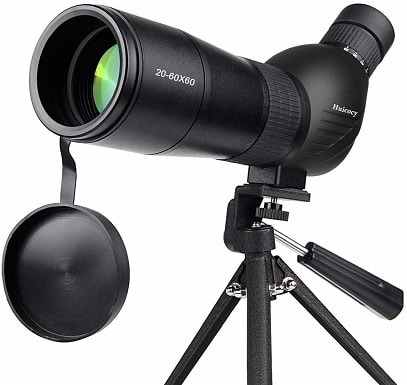
The Huicocy 8595750877 Spotting Scope is our choice for best value, and we believe that after looking over what this scope has to offer, you will agree it’s the best spotting scope for target shooting for the money. It features a 60-mm objective lens for a bright image and a wide field of view. Anti-glare multi-coating helps keep the image clear. It features a 20-60x zoomable eyepiece with plenty of eye relief. This spotting scope can also connect to your cellphone so that you can take pictures and movies, and it features a durable frame with rubber armor protection.
The only thing that prevents this from being our top choice is the 60-mm objective lens. The only thing we didn’t like is that it’s hard to use while wearing glasses due to the design of the eyepiece.
Overall, this is definitely one of the best budget spotting scopes for target shooting this year.
- Low cost
- 20-60x zoom
- Cell phone connection
- Hard to use wearing glasses.
3. Vortex Optics Diamondback Spotting Scope – Premium Choice
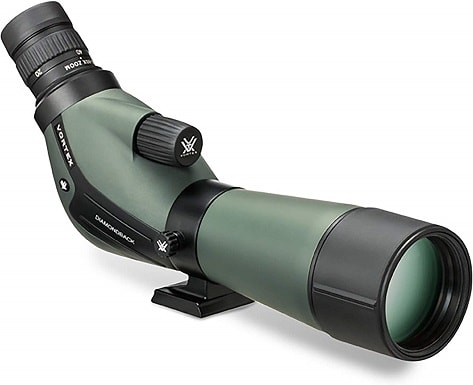
The Vortex Optics Diamondback is our premium choice. This full-featured scope is for the person who wants the best spotting scope regardless of cost. The Diamondback features a 60-mm objective lens and 20-60x magnification. We were able to get a clear image with accurate colors during our review, and the adjustable eyepiece improved comfort considerably. The scope is waterproof and will not fog up during use. A durable rubber armor coating protects the scope from weather and accidental falls.
The high price and smaller objective lens prevent this scope from ranking higher. For the price of this model, we would have liked to have an 80-mm objective lens. The ability to connect the scope to our phone is also absent.
- Clear image
- Adjustable eyepiece
- Durable
- Waterproof
- Small objective lens
- No phone connection
4. Roxant Blackbird Spotting Scope
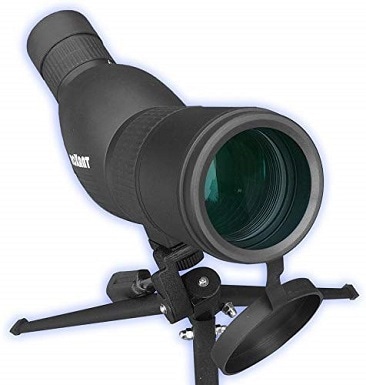
The Roxant Blackbird High Definition Spotting Scope is a simple but powerful tool. It features a 45-degree bent scope and a non-slip weatherproof rubber armor construction. It has an extendable and retractable eyepiece for using the scope while wearing glasses that we liked. The 12-36x zoom lens looked bright clear and focusing was smooth during our review.
We did notice a slight wobble when using the scope with a tripod. The wobble was due to the tripod mount on the scope and seemed minimal at first but is very noticeable when fully zoomed in on a target. While the image looked good, we do wish the 50-mm objective lens was a little larger.
- Rubber armor construction
- Bright, clear image
- Retractable eyepiece
- Wobbles on tripod munt
- 50-mm objective lens
5. Gosky Target Shooting Spotting Scope
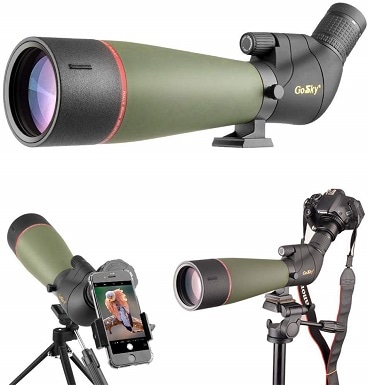
The Gosky Spotting Scope is an excellent scope with some nice features. It has a large 80-mm objective lens for letting plenty of light in and providing a large field of view. The multi-coated lens prevents glare and shadows, and the clear image offers more contrast than we see in a lot of models. The retractable sunshade is a nice touch that further reduces glare on the lens, and the 20-60x zoom lens allowed us to get a close view of any object we chose. This spotting scope also features connections for cell phones and cameras that we really liked.
The only problem we had with this model is the plastic foot collar that connects to a tripod. It doesn’t hold the scope steady enough, and our image had a lot of vibration, especially when using the zoom on windy days. A better design or some shock absorbers would be a great addition.
- 80-mm Objective lens
- 20-60x zoom
- Phone and camera inputs
- Plastic foot collar
6. LANDOVE Prism Spotting Scope
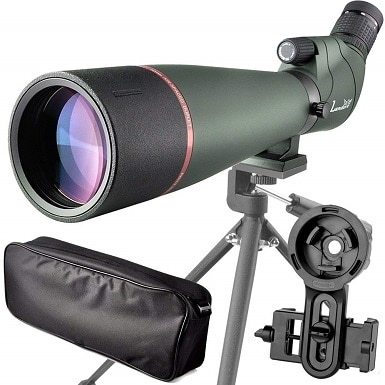
The LANDOVE Prism Spotting Scope is another large scope capable of long-range target practice. It features an 80-mm objective lens and gives you the capability of zooming 20-60x closer to your target. Green tint-coated lenses provided us with a clear image without glare. This scope also provides you with a Digiscoping cell phone adapter for taking pictures, movies, and collecting other useful data.
We didn’t like the included tripod or the phone mount. We found it challenging to attach and line up our phone. When we finally achieved lining it up, it was shaky and flimsy. Attaching the scope to the low-quality tripod only made the problem worse.
- 80-mm objective lens
- 200-60x magnification
- Cell phone connection
- Cell phone mount hard to adjust
- Low-quality tripod
7. SVBONY SV28 Target Shooting Spotting Scope
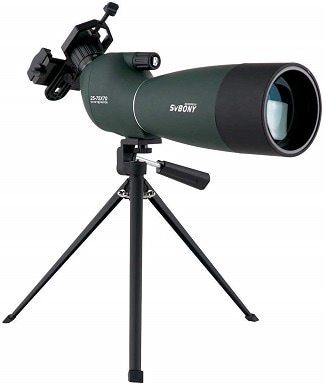
The SVBONY SV28 Spotting Scope features a 70-mm objective lens that provided us with a bright and clear image when we used it on the low magnification setting. It features the ability to zoom 25-75x closer to your target and is one of the longer zooms on this list. The lenses are coated to reduce glare, and the eyepiece has a handy foldable rubber end for using the scope while wearing glasses. There is also a universal phone attachment for taking pictures and movies.
We felt that as you approach the ambitious 75x zoom, the exit pupil becomes too small, and the image quality suffers and becomes dim. The phone mount is also flimsy and is something you find yourself fiddling with instead of using the scope.
- 70-mm objective lens
- Foldable rubber eyepiece
- Poor image when zoomed-in
- Flimsy phone mount
8. Kalawen CPWYJ Spotting Scope
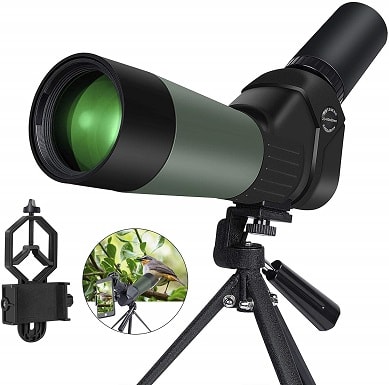
The Kalawen CPWYJ-US-01 Spotting Scope is a low-cost scope with some excellent features. It has a 60-mm objective lens that we felt produced a nice picture. For the most part, the 20-60x zoom capability allowed us to get up close to some distant targets. The retractable sun shield and phone adapter are also useful additions.
While the image is nice, we feel the construction is not very durable. It uses lightweight plastic that’s not going to hold up well, and it certainly isn’t going to handle any accidental drops.
- Low cost
- 60-mm lens
- Cell phone connection
- Weak plastic frame
9. Bushnell Trophy Xtreme Spotting Scope
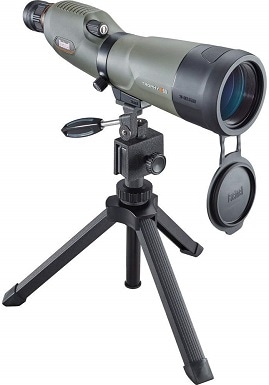
The Bushnell 886520 Trophy Xtreme Spotting Scope is a smaller-sized scope equipped with a 50-mm objective lens. It can close focus at 12 feet and can bring objects up to 36x closer. It features a 14-mm eye relief for easy viewing of your target. We liked the waterproof design and durable rubber coating.
We didn’t like the small 50-mm lens. While the image remains clear due to the low magnification of the zoom lens, it doesn’t have a beneficial range. There are no connections for a cell phone, and we felt it was expensive for the features offered.
- Clear image
- Waterproof
- Small objective lens
- 32x zoom
- Expensive
10. FEEMIC Waterproof Spotting Scope
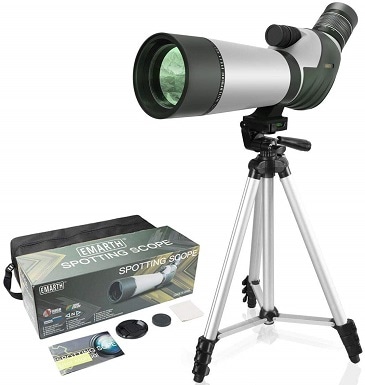
The FEEMIC Waterproof Spotting Scope is the final spotting scope on our list. While this scope is certainly not as good as our first few choices, there might be some features that interest you. This model has a 60-mm objective lens, which can produce a good image at a decent zoom, and this model brings the object 60x closer, which is on par with many of the other scopes on this list.
While the dual zoom controls are intended to help you focus on your target faster, we found the opposite to be true. When using this scope without looking at the controls and while wearing gloves, we found it easy to turn the wrong dial. While target practice doesn’t require high-speed focus, we found it distracting. This model also tended to fog on us and there’s no way to connect a cell phone.
- 60-mm lens
- 20-60x zoom
- Dual zoom controls
- Easily fogs
- No cell phone connection

Buyer’s Guide – Finding the Best Spotting Scope for Target Shooting
Let’s look at the different aspects of a spotting scope for target practice and see what makes one model better than the next.
Eye Relief
Eye relief is the distance from the last lens in the scope to your eye. Usually measured in millimeters, the higher the number, the further you can be from the scope and still see the image. Eye relief is an important feature of any ocular device. The eye relief is more important on a gun-mounted scope than a tripod mount, but it can make a big difference in the usability of any scope.
Objective Lens
The objective lens is the lens furthest from your eye. The objective lens is responsible for letting the light in to give you a big and bright image in your scope. It’s also responsible for the field of view. The larger the lens is, the more light will be allowed to enter the scope. So, bigger is better here, with most recommendations calling for an objective lens larger than 60 mm.
Magnification
Magnification is a vital part of every spotting scope, and there are two kinds of lenses, fixed lenses, and zoom lenses.
Fixed Lens
Fixed lenses are the type that has a fixed magnification that doesn’t change. You need to switch lenses to change the magnification. These lenses traditionally produce a higher quality image than zoom lenses and do a better job collecting light.
Zoom Lens
Zoom lenses are the type that is manipulated to change its magnification. This lens is very common, and every device on our list has one. These lenses don’t produce as good an image as a fixed lens, but modern technology is quickly closing the gap.
Try to find a spotting scope with more zoom than you need to ensure the device works well.
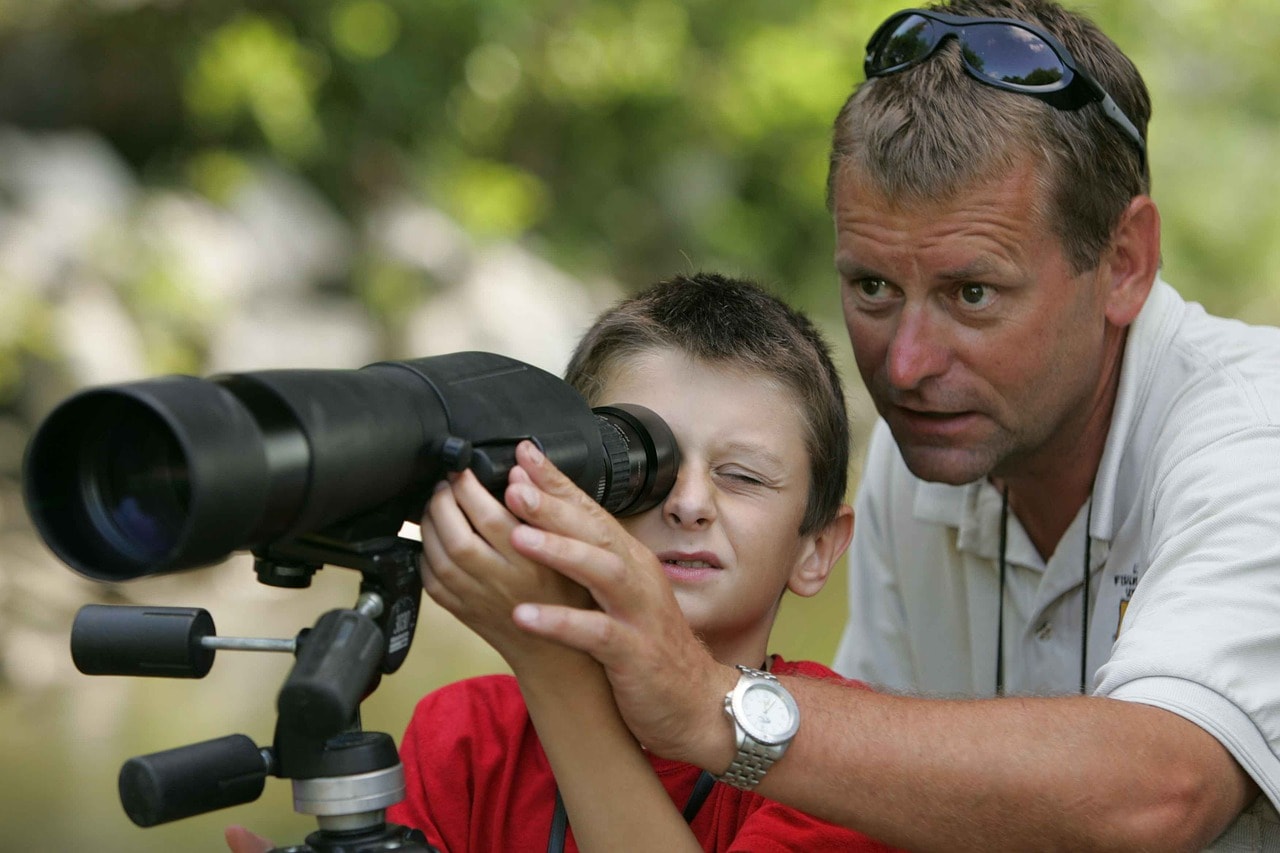
Focus method
There are two common ways to focus and zoom on your target with a spotting scope.
The Eyepiece Twist
The first (and most common) method is to twist the eyepiece until your target comes into focus. This method is fast, and it feels right, but it is difficult to focus on tiny increments. A small twist of the eyepiece can zoom several feet closer to your target.
Stand Alone Zoom
The stand-alone zoom has a separate control for the zooming. On spotting scopes, this control often resembles a small second scope on top of the regular one. This type of zoom is much slower than the eyepiece twist, but it’s possible to zoom in tiny increments, even at long distances, and achieve better focus.
Waterproof
Even though we will be using our spotting scope for target shooting, we never know what type of weather we will encounter. You want to make sure your spotting scope is waterproof or at least water-resistant.
Weight
The weight of the spotting scope is a more significant issue when mounted on a gun, but it’s still important if you need to carry it long distances.
Anti-Reflective and Anti-Glare Lenses
Anti-reflective and anti-glare lenses can help give you a clear image. Lenses without these treatments can deliver an image with spots or an image that’s washed out. Glare can also make it very difficult to read any information the scope is providing.
SEE ALSO: should you choose a telescope or a spotting scope?
Exit Pupil
The exit pupil is the term we use for the light that exits the scope and reaches the eye. A larger exit pupil will produce a brighter image. Zooming-in will reduce the size of the exit pupil and is something that needs consideration when choosing your spotting scope. Scopes with a lot of zoom capability can wind up with a tiny exit pupil that’s difficult to see. Larger front lenses can collect more light and result in a larger exit pupil.
Field of View
Field-of-view is a term that means the amount of terrain visible through your scope. A larger field of view can help you locate targets quicker and help prevent disorientation while looking through the scope.
Straight or Bent
There are two common types of spotting scopes in use, the straight scope, and the bent scope. In this case, we are talking about how we look through the scope to see our target.
Straight Scope
The Straight scope is just as the name suggests. The straight scope is like a straight pipe with lenses in it. You look through one end directly at your target. Straight is the type of scope most commonly found on rifles. Pirates in pirate movies tend to use this type of scope.
Bent scope
The Bent scope is the type that uses mirrors to position the eyepiece at a 45-degree angle. Bent scopes are perfect to use with a tripod, and they make it easier to look at objects above you.
External Devices
Many of the best spotting scopes allow the connection of external devices. The most common external devices to connect are your smartphone and camera. These devices may or may not be useful during your target shooting. The smartphone can track all sorts of data that you can use to improve your aim, and a camera hookup can help you get some great pictures of the wildlife.
Spotting Scope Tips
- Test your scope under a variety of conditions
- Take time to choose a spot with a good view
- Use plenty of support. Larger tripods work better
- Be aware of heat and humidity’s effect on range
- Rest your eyes
We also have some more in-depth tips here.
Also see: Different Types of Scopes Reticles

Conclusion:
Now that you have had a chance to read over our reviews, and our buyer’s guide, we hope that you feel more informed and capable of choosing a spotting scope for target practice. We stand by our choice for best overall. The Celestron 5220 has a high-quality image with plenty of zoom. With this model you purchase superior lenses instead of features you don’t need for target practice. Our best value is also a great choice and loads you up with extra features at a bargain.
If you feel that reading this article has made you more confident about your next spotting scope purchase, please share this article on social media so we can help others as well.
We truly hope that you find the best target-shooting spotting scope for your needs!
Table of Contents
- Our Favorites Choices of 2025 Compared
- The 10 Best Spotting Scopes for Target Shooting
- 1. Celestron Ultima Spotting Scope – Best Overall
- 2. Huicocy Spotting Scope – Best Value
- 3. Vortex Optics Diamondback Spotting Scope – Premium Choice
- 4. Roxant Blackbird Spotting Scope
- 5. Gosky Target Shooting Spotting Scope
- 6. LANDOVE Prism Spotting Scope
- 7. SVBONY SV28 Target Shooting Spotting Scope
- 8. Kalawen CPWYJ Spotting Scope
- 9. Bushnell Trophy Xtreme Spotting Scope
- 10. FEEMIC Waterproof Spotting Scope
- Buyer’s Guide – Finding the Best Spotting Scope for Target Shooting
- Conclusion:
About the Author Robert Sparks
Robert’s obsession with all things optical started early in life, when his optician father would bring home prototypes for Robert to play with. Nowadays, Robert is dedicated to helping others find the right optics for their needs. His hobbies include astronomy, astrophysics, and model building. Originally from Newark, NJ, he resides in Santa Fe, New Mexico, where the nighttime skies are filled with glittering stars.
Related Articles:
How to Clean a Refractor Telescope: Step-by-Step Guide
How to Clean a Telescope Eyepiece: Step-by-Step Guide
How to Clean a Rifle Scope: 8 Expert Tips
Monocular vs Telescope: Differences Explained (With Pictures)
What Is a Monocular Used For? 8 Common Functions
How to Clean a Telescope Mirror: 8 Expert Tips
Brightfield vs Phase Contrast Microscopy: The Differences Explained
SkyCamHD Drone Review: Pros, Cons, FAQ, & Verdict



